The Acer Swift 3 SF314 Notebook Review: Swift Gets Swifter With Ryzen 4000
by Brett Howse & Andrei Frumusanu on May 5, 2020 8:00 AM ESTGPU Performance
Ever since the original Raven Ridge systems, AMD’s Zen-based APUs have set the bar for GPU performance in a 15-Watt package. Coupling AMD’s Vega GPU cores with their Zen CPU cores really changed the game in terms of integrated GPU performance. Their second-generation Picasso platform even bumped the compute unit count up to 11 with the Ryzen Microsoft Surface Edition processor, which was once again based on Vega.
AMD’s philosophy has changed slightly for their third generation Zen-based APU, Renoir. Thanks to the move to TSMC’s 7 nm process, they decided to cut back the GPU cores, but provide more frequency headroom, and coupled with the CPU performance gains of Zen 2, AMD promised faster GPU performance despite the reduction in compute units. So, for the Ryzen 7 models, they are now offering either seven compute units on the Ryzen 7 4700U we have in our review unit, or eight compute units in the Ryzen 7 4800U, with maximum frequencies of 1600 Mhz and 1750 MHz respectively. That means that the unit we are testing today is down four compute units compared to the Ryzen 7 3780U found in the Surface Laptop 3, and although the maximum boost frequency is higher, it is only 200 MHz higher than the best Picasso APU available. We’ve seen AMD ramp up frequency before to get more performance out of their GPUs, and it has served them well, but in a laptop platform, there is far less thermal room to work with, so we shall see how the new philosophy works out for them.
Our testing philosophy for laptops with integrated GPUs has had to evolve very quickly. Laptops based on Intel’s Gen 9.5 graphics had such poor GPU performance that it was not even worth testing them against most 3D games, but both AMD’s Vega GPU on Ryzen, and Intel’s Iris graphics in their Ice Lake SoC have both moved the bar upwards, so more vigorous testing is now required. As with any new testing we bring, please give us some time to fill in the data as we test new devices.
3DMark


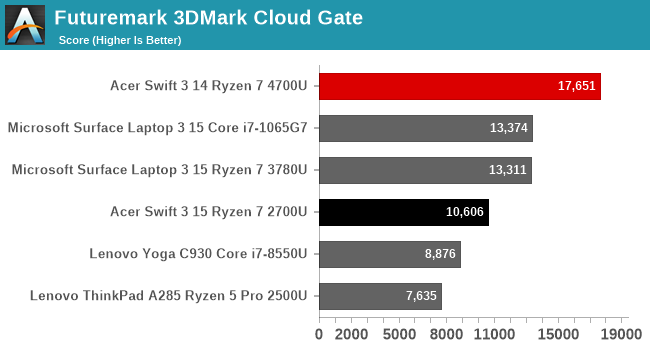
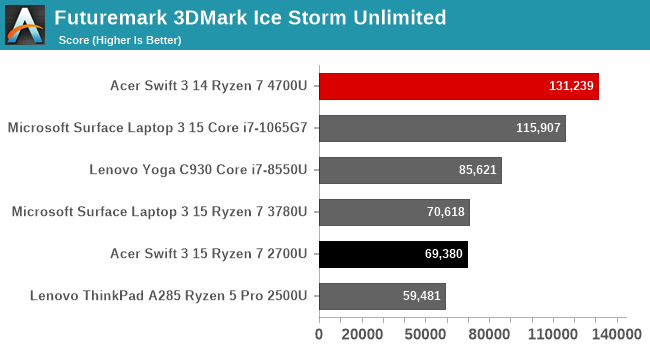
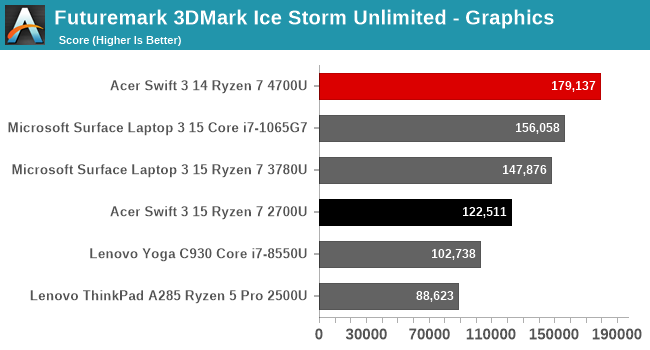
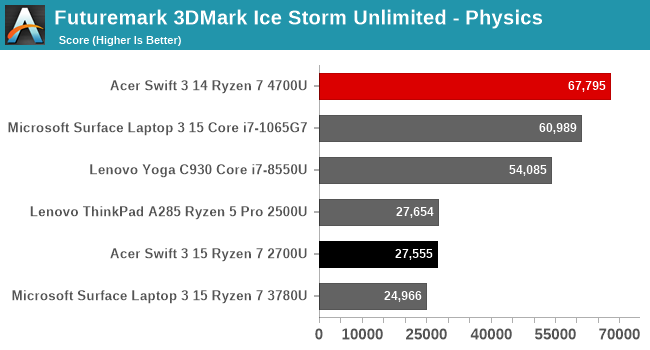
UL’s 3DMark suite offers a range of tests of varying complexity, from the high-end Fire Strike, down to Ice Storm Unlimited, which can be run on smartphones. The Acer Swift 3 is off to a great start with these DX11 based tests, easily outperforming the previous Picasso scores as well as Intel’s Ice Lake platform. The most interesting result is the Ice Storm Unlimited Physics results, where Renoir scores 2.7 times higher than Picasso. The Physics tests are really CPU bound tests, which clearly shows how CPU limited the previous AMD APUs had been.
GFXBench

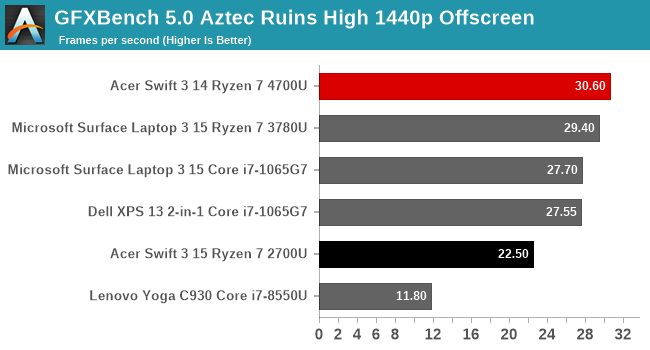
Thanks to the new DX12 tests Kishonti introduced with version 5.0 of their GFXBench suite, this cross-platform benchmark is again relevant on Windows. The results from the Ryzen 7 4700U are interesting. AMD has often done well on DX12, likely thanks to their early efforts with low-level drivers, and their previous Picasso GPU did very well on this benchmark. The Renoir does surpass Picasso, but the margin of victory is small.
Tomb Raider
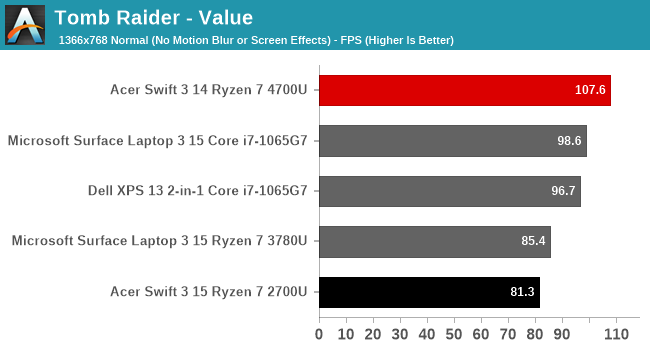
Although a bit long in the tooth, the original Tomb Raider reboot can still be taxing on notebooks, although the game is certainly playable on the modern integrated GPU if you turn down the settings. On our value settings the Acer Swift 3 was able to achieve over 100 frames per second, meaning there is quite a bit of room to increase the quality as long as you keep the resolution down. On both Ice Lake and Renoir, the game is unplayable with our Enthusiast settings at 1920x1080, despite its age.
Rise of the Tomb Raider
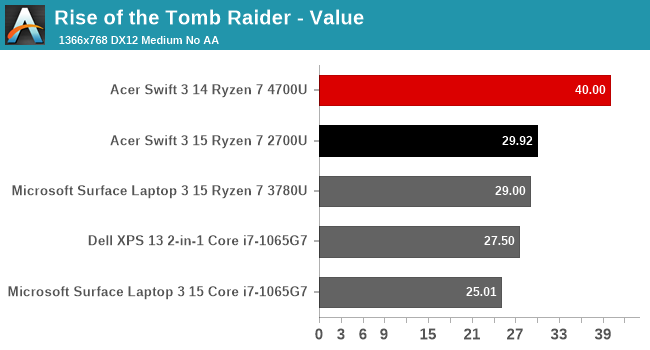
The first sequel to Tomb Raider added DX12 support, and as usual that means our AMD APUs did well. Although the game would be barely playable on Picasso or Ice Lake, the Acer Swift 3 with Ryzen 7 4700U looks like it just squeezes past the 30 FPS minimum you’d really want. This game is still at the limits of integrated GPUs.
Strange Brigade
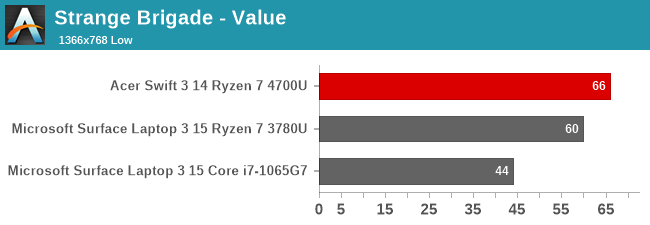
The co-operative third person shooter Strange Brigade is a DX12 title that does well even on integrated GPUs. It also appears to be more CPU bound than some of the other DX12 titles in our list, so the extra performance offered by the Zen 2 cores in the Acer Swift 3 help propel it to the top, with far more performance than the previous generation AMD APU.
F1 2019
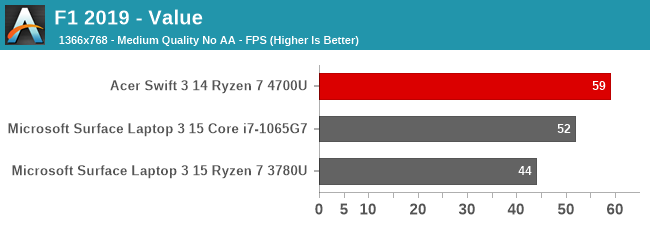
Codemaster’s F1 series is yet another game that can do well even on integrated graphics if you want to turn the settings down. The Acer Swift 3 does very well here, almost achieving an average of 60 frames per second.
Far Cry 5
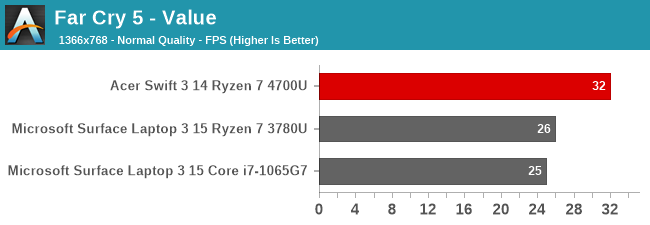
Ubisoft’s Far Cry franchise is well known, but it’s also been impossible to play on most integrated GPUs. That is still the case with the Acer Swift 3, although it just manages over 30 frames per second in this test, outclassing all other integrated notebooks tested. We will get into this a bit later, but this game also showed some very severe thermal throttling, with major dropouts in framerate during the benchmarking.
GPU Results
Although AMD cut back on the size of the GPU in Renoir, they don’t seem to have hurt maximum performance, and the new Zen 2 cores really show that the previous Raven Ridge and Picasso APUs were very CPU bound on some titles. With 36% fewer compute units than the Ryzen 7 3780U found in the Surface Laptop 3, the Acer Swift 3 still manages to outperform it in all cases.
However, the Acer did run into thermal issues when running at maximum performance. Some of this will come down to the cooling system in this particular notebook, but the power management of the Renoir APU also did not seem to be able to cope very well. Rather than find a sweet spot where it can perform well without throttling, the frame rate in Far Cry 5 was like a roller coaster the longer you left the game running. AMD’s choice to cut back on the number of compute units and then increase frequency certainly won’t help here either, and it makes you wonder how well the GPU would have been able to perform on the new 7 nm process with more CUs but a lower maximum boost frequency. We will dig more into the thermals later in the review.










191 Comments
View All Comments
lightningz71 - Tuesday, May 5, 2020 - link
It appears that the Acer Swift design philosophy just doesn't translate for anything that requires a high steady-state power draw and thermal load. The Swift had the same issues with the 2XXX and 3XXX series chips as well, so this is nothing new. This is something that Acer has deliberately chosen to make a design trade-off for: sacrifice some thermal dissipation ability to keep the product in the size class that it is intended for.It will be interesting to see the benchmarks on the 4500U in this platform. It was shown in benchmarks of previous versions of the swift that lower end APUs actually performed better in gaming than the top end parts because the system was better able to manage the thermal output and the APU was better able to keep consistent clocks. While the absolute performance was still lower than notebooks with better thermal management implementations, it was a better gaming performer than the top end SKU.
neblogai - Tuesday, May 5, 2020 - link
Generally, you are not complaining about Acer, but about U-series chips from both Intel or AMD. The philosophy of laptops with ~15W chips is that these chips are used in ultrabooks that are responsive and fast in short boosts, and not made for steady power (even if there are some premium devices that offer both).fmcjw - Tuesday, May 5, 2020 - link
The 2019 Swift 5 and LG Gram series were matched to the thermal promises of Intel 10nm chips that took 2 generations to arrive, and maybe 5nm AMD SoCs in 2021 since AMD decided to rush to market with last generation GPU architecture in early 2020. Perhaps with software or AI based optimization, there can be a more optimal mix of processes split between the CPU versus the GPU for best performance within thermal constraints. Not every task is as clear cut as gaming routines, where more of the work is performed more efficiently on the GPU. I'm not sure that will happen though, as such software optimization has the least return on investment outside cloud and data center applications. Not even Apple wants to do it for the 2020 Macbook Air, thermally crippling a fine Intel chip and resolving the issue by sticking a more powerful cooling solution in a Macbook Pro (and charge more).For 2020, Acer managed to get the Swift 3 down to 1.2kg from 1.45kg of the 2019 model through the use of aluminum AND magnesium (not just aluminum as the article states). The 2020 Swift 5 maintains a 1kg weight while including a rare-breed matte touch screen. The Swift 5 is the model you want to get for 100% sRGB at a $300 premium. I think the only reason these fine machines sell for $600 to $900 for a mid-range configuration is the thermally constrained performance of the more stubbornly ambitious SoCs.
Which if they can think outside the box can easily resolve by selling a fan-assisted cooling dock and unleash the full potential of the SoC we already paid for (and charge more).
Fulljack - Tuesday, May 5, 2020 - link
while Vega here is based on GCN 5 and not RDNA, it doesn't mean it's an outdated architecture. AMD did enhance the Vega arch for Ryzen 4000, with 56% improvement over Vega arch found in Ryzen 3000. overall, with enhanced arch, reduced core count, and higher clock, AMD did deliver 2020 Vega 8 that performs 28% better than 2019 Vega 11.https://www.anandtech.com/show/15324/amd-ryzen-400...
Oxford Guy - Thursday, May 7, 2020 - link
All irrelevant when the laptop's cooling is so pathetic:"The laptop really struggled with its thermals, dropping the framerate into single digits often. The device attempted to run at around 18 Watts of power draw, slightly over the 15 Watt TDP, but in fact only averaged around 8 Watts during this run."
csp4me - Tuesday, May 5, 2020 - link
Acer Swift 3 and 5 are in the market for lightweight, cool & quiet laptops within thermal constraints, thus ~ 18W tdp, and throttling under stress test.For the same budget of Acer Swift 5 ~ $900 you can find laptop models with the same quality display or better and also better thermals ~ 28W-35W at the expense of weight 1.3-1.4kg and noise/heat during heavy loads. Examples Lenovo Ideapad S540-13 both AMD or Intel, or Yoga Slim 7 both AMD or Intel.
psychobriggsy - Tuesday, May 5, 2020 - link
When you buy low power laptops - Y or U series TDPs - you are really looking out for these things1) Sustained Single Core Clock
2) Sustained All-Core Clock
3) Race-To-Sleep Single Core Turbo Boost (and the time it can sustain this)
4) Race-To-Sleep All-Core Turbo Boost (and the time it can sustain this)
1 and 2 are what your gaming sessions will occur in. 3 and 4 might help in some particularly CPU-heavy parts, but only for small periods of time.
This is the problem Intel have with their 14++++ chips - 1 and 2 cannot be raised in the TDP they are restricted to (unlike desktop, where they can simply lie about the figures, in a laptop this will affect battery life and be easily detected), so they hype 3 and 4 to compensate.
AMD on 7nm does well in all four measures, but you should never think you'll get long-term turbo clock performance from any mobile chip. I don't know if Renoir has a 4C turbo that can last longer than the 8C turbo for lightly threaded loads.
fmcjw - Tuesday, May 5, 2020 - link
Can a Y or U series SoC be considered the equivalent of an H series SoC internally, with a beefier cooling solution and reduced I/O capabilities externally? I imagine not just the I/O or cooler but also the capacitors and power circuitry need to be higher specified for the higher sustained load.It's just that few makers even try to create a balanced system around the U or Y series, letting Turbo Boost go wild to impress for the first minute or two, or restraint the system thermally to achieve longer battery life even when you can plug it in.
T1beriu - Tuesday, May 5, 2020 - link
>the mobile chips here only feature half the L3 cache compared to its desktop counterpartsSmall correction. Ryzen 4000 actually has a quarter.
ads295 - Tuesday, May 5, 2020 - link
Acer has consistently impressed me with their attention to detail. There are so many moronic OEMs that put in a single module of RAM but even my 2016 Acer E5-553-T4PT came with 2 modules of 2GB DDR4 RAM to enable the A10-9600P to run in dual channel mode.I suppose they don't get paid to debilitate AMD setups.